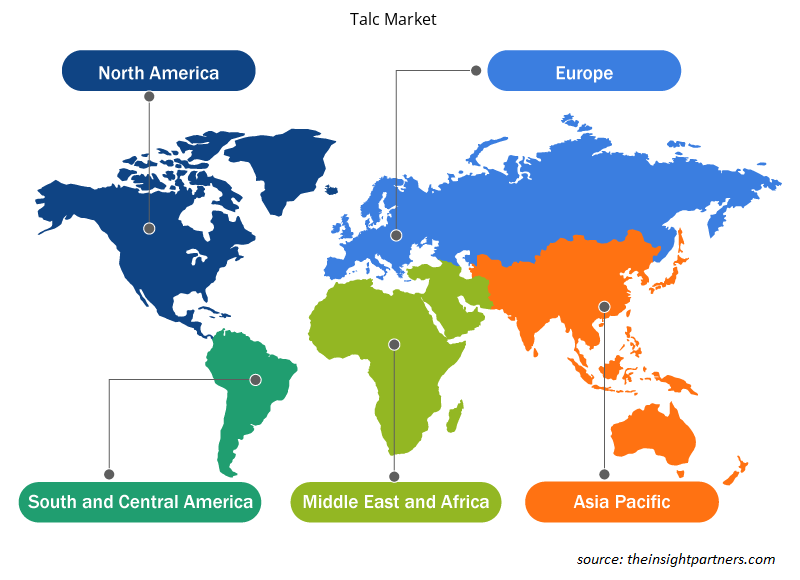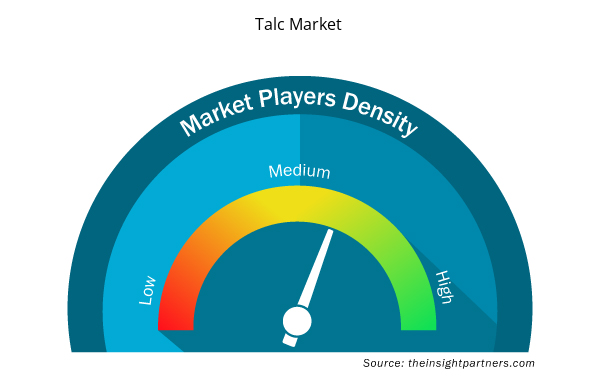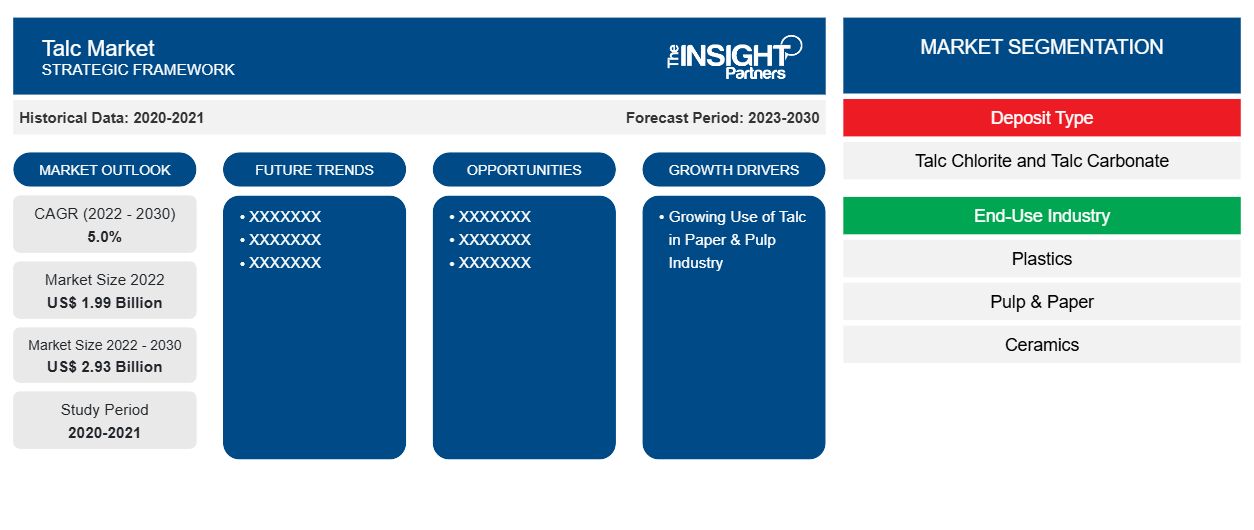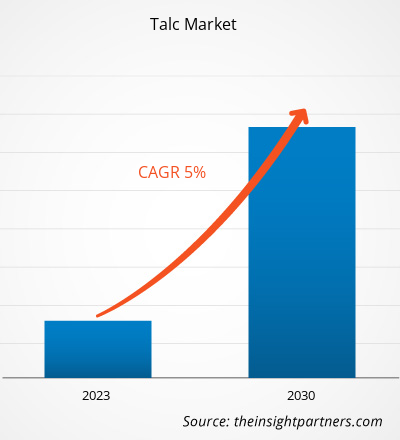[تقرير بحثي] من المتوقع أن ينمو حجم سوق التلك من 1،987.43 مليون دولار أمريكي في عام 2022 إلى 2،932.29 مليون دولار أمريكي بحلول عام 2030؛ ومن المتوقع أن يسجل معدل نمو سنوي مركب بنسبة 5.0٪ من عام 2022 إلى عام 2030.
رؤى السوق ووجهة نظر المحلل:
التلك هو سيليكات المغنيسيوم المائية. تتشكل رواسب التلك من تحويل الصخور ذات المحتوى العالي من المغنيسيوم بواسطة السوائل الحرارية المائية السليكية. ينشأ معظم التلك من تغيير الدولوميت أو الصخور المتطفلة فوق المافية. يوجد دائمًا في تركيبة مع معادن أخرى، بشكل عام الكربونات والكلوريت. كل رواسب التلك لها مورفولوجيا ومعادن فريدة من نوعها، ولكن جميع أنواع التلك تظهر الخصائص الفريدة التالية - النعومة، وطرد الماء، والخمول الكيميائي، والبلاتينية، والتقارب للمواد العضوية. تجعل هذه الخصائص التلك مناسبًا كحشو متعدد الوظائف وممكّن للعمليات في مجموعة واسعة من التطبيقات من البلاستيك إلى الورق والسيراميك إلى الطلاء. يستخدم التلك كعامل مضاد للالتصاق، وعامل مضاد للتكتل، ومادة تشحيم، وناقل، ومكثف، وحشو مقوي، وحشو ناعم، وممتز. إن المحرك الرئيسي لنمو سوق التلك هو الطلب المتزايد من مختلف الصناعات ذات الاستخدام النهائي مثل السيراميك والبلاستيك والدهانات والطلاءات والأغذية والزراعة. يعد قطاع السيراميك القطاع الأكثر جاذبية ويخلق فرصًا مربحة في سوق التلك العالمية. تعد صناعة البلاستيك مستهلكًا أساسيًا آخر للتلك. يستخدم التلك بشكل أساسي كحشو في البلاستيك.
محركات النمو والتحديات:
يُستخدم التلك بشكل شائع في صناعة اللب والورق كعامل للتحكم في درجة الالتصاق، وصبغة الطلاء، وحشو وظيفي. يساعد التلك في تعزيز قابلية تشغيل آلة الورق. يُستخدم التلك لإعادة تدوير الورق وإنتاج ورق جديد، ولب، وكرتون. تمنع خصائص التلك تكتل الالتصاق داخل آلة الإنتاج. يُستخدم التلك كحشو لإضفاء النعومة والمسامية والعتامة على الورق. كما يعمل التلك في إنتاج الورق على تحسين جودة المنتجات النهائية وتقليل تكاليف الإنتاج. علاوة على ذلك، يُستخدم التلك في العديد من الصناعات النهائية مثل الدهانات والطلاءات والبلاستيك والزراعة والأغذية. في صناعة الطلاء، يقلل استخدام التلك من استخدام الصبغة الأولية في إنتاج الطلاء، مما يقلل من تكاليف التصنيع. يعزز التلك طبقة الطلاء ويحسن من متانته ومقاومته للبقع. نظرًا لخصائصه المثبطة للصدأ ومقاومة التآكل، فإن الطلاء يدوم لفترة أطول. كما يعمل التلك كممدد على زيادة لزوجة الطلاء. إن النمو القوي لقطاعات البناء والسيارات والصناعة يدفع الطلب على الدهانات والطلاءات. يتم استخراج التلك من الأرض. وقد يحتوي على الأسبستوس، وهو مادة شديدة السمية. يوجد الأسبستوس تحت الأرض، وغالبًا ما يمكن العثور على عروقه في رواسب التلك، مما يؤدي إلى خطر التلوث المتبادل. وبالتالي، هناك احتمالات عالية لوجود التلك الملوث بالأسبستوس في منتجات مختلفة. يمكن أن يؤدي التعرض الطويل الأمد للأسبستوس إلى زيادة مخاطر الإصابة بالسرطان، وخاصة الورم المتوسطة (سرطان الرئة)، وسرطان المبيض، وسرطان الحنجرة.
قم بتخصيص هذا التقرير ليناسب متطلباتك
ستحصل على تخصيص لأي تقرير - مجانًا - بما في ذلك أجزاء من هذا التقرير، أو تحليل على مستوى الدولة، وحزمة بيانات Excel، بالإضافة إلى الاستفادة من العروض والخصومات الرائعة للشركات الناشئة والجامعات
- احصل على أهم اتجاهات السوق الرئيسية لهذا التقرير.ستتضمن هذه العينة المجانية تحليلاً للبيانات، بدءًا من اتجاهات السوق وحتى التقديرات والتوقعات.
تقسيم التقرير ونطاقه:
ينقسم سوق التلك العالمي على أساس نوع الودائع وصناعة الاستخدام النهائي. بناءً على نوع الودائع، يتم تقسيم سوق التلك إلى كلوريت التلك وكربونات التلك. بناءً على صناعة الاستخدام النهائي، يتم تقسيم سوق التلك إلى البلاستيك واللب والورق والسيراميك والدهانات والطلاءات والمطاط والمستحضرات الصيدلانية والأغذية وغيرها. من حيث الجغرافيا، يتم تقسيم سوق التلك العالمي على نطاق واسع إلى أمريكا الشمالية وأوروبا وآسيا والمحيط الهادئ والشرق الأوسط وأفريقيا وأمريكا الجنوبية والوسطى. يتم تقسيم سوق التلك في أمريكا الشمالية إلى الولايات المتحدة وكندا والمكسيك. يتم تقسيم السوق في أوروبا إلى ألمانيا وفرنسا والمملكة المتحدة وإيطاليا وروسيا وبقية أوروبا. يتم تقسيم سوق التلك في منطقة آسيا والمحيط الهادئ إلى الصين والهند واليابان وأستراليا وكوريا الجنوبية وبقية منطقة آسيا والمحيط الهادئ. يتم تقسيم سوق الشرق الأوسط وأفريقيا إلى جنوب إفريقيا والمملكة العربية السعودية والإمارات العربية المتحدة وبقية منطقة الشرق الأوسط وأفريقيا. يتم تقسيم سوق التلك في أمريكا الجنوبية والوسطى إلى البرازيل والأرجنتين وبقية أمريكا الجنوبية والوسطى.
التحليل القطاعي:
بناءً على نوع الودائع، يتم تقسيم سوق التلك إلى كلوريت التلك وكربونات التلك. احتل قطاع كربونات التلك حصة سوقية أكبر في عام 2022. تحتوي أجسام خام كربونات التلك بشكل أساسي على كربونات التلك وآثار الكلوريت. غالبًا ما توجد هذه الرواسب في الصخور المتحولة ويمكن اعتبارها نوعًا فرعيًا من الرواسب المتحولة. في رواسب كربونات التلك، غالبًا ما يرتبط تكوين التلك بالتناوب بين الصخور الموجودة مسبقًا الغنية بالمعادن الغنية بالمغنيسيوم. يحل التلك محل هذه المعادن تحت تأثير الظروف المتحولة، مما يؤدي إلى تطور الصخور الغنية بالتلك. تتم معالجة خامات كربونات التلك لإزالة المعادن المرتبطة بها وإنتاج مركز التلك النقي. بناءً على صناعة الاستخدام النهائي، يتم تقسيم سوق التلك إلى البلاستيك واللب والورق والسيراميك والدهانات والطلاء والمطاط والمستحضرات الصيدلانية والأغذية وغيرها. كانت حصة التلك في سوق قطاع اللب والورق ملحوظة في عام 2022. في صناعة اللب والورق، يتم استخدام التلك كحشو للورق، حيث أن له تأثير سلبي ضئيل على قوة الورقة ولكنه يحسن استقبال الحبر بهامش كبير. كما أنه يعزز العتامة والسطوع ويقلل اللمعان. يمكن استخدام التلك في إعادة تدوير الورق والإنتاج الجديد للورق واللب والكرتون كحشو. يحسن استخدام التلك خصائص المنتجات النهائية ويقلل من تكاليف الإنتاج.
التحليل الإقليمي:
تم تقسيم سوق التلك إلى خمس مناطق رئيسية - أمريكا الشمالية وأوروبا وآسيا والمحيط الهادئ وأمريكا الجنوبية والوسطى والشرق الأوسط وأفريقيا. سيطرت منطقة آسيا والمحيط الهادئ على سوق التلك العالمية، والتي بلغت قيمتها حوالي 950 مليون دولار أمريكي في عام 2022. كما تعد أمريكا الشمالية مساهمًا رئيسيًا، حيث تمتلك حصة كبيرة في سوق التلك العالمية. ومن المتوقع أن يصل سوق التلك في أمريكا الشمالية إلى أكثر من 300 مليون دولار أمريكي بحلول عام 2030. ومن المتوقع أن تسجل أوروبا معدل نمو سنوي مركب كبير يزيد عن 5٪ من عام 2022 إلى عام 2030. تعد أستراليا والصين والهند واليابان وكوريا الجنوبية المساهمين الرئيسيين في سوق التلك في منطقة آسيا والمحيط الهادئ. تعد منطقة آسيا والمحيط الهادئ واحدة من أكبر مناطق إنتاج التلك الخام والمعالج على مستوى العالم. تعد المنطقة موطنًا لكبار الشركات المصنعة التي تنتج البلاستيك خفيف الوزن لمكونات السيارات. ومن المتوقع أن يؤدي التصنيع السريع والزيادة في الدخل المتاح لسكان الطبقة المتوسطة في الاقتصادات الناشئة إلى دفع الطلب على التلك في منطقة آسيا والمحيط الهادئ. وبحسب المنظمة الدولية لمصنعي السيارات (OICA)، ارتفع إنتاج السيارات في آسيا وأوقيانوسيا من 44.2 مليون سيارة في عام 2020 إلى 46.7 مليون سيارة في عام 2021.
تطورات الصناعة والفرص المستقبلية:
فيما يلي قائمة بالمبادرات المختلفة التي اتخذتها الجهات الفاعلة الرئيسية العاملة في سوق التلك:
- في فبراير 2021، أعلنت شركة Magris Resources Canada Inc. أنها دخلت في اتفاقية وساطة نهائية للاستحواذ على جميع أصول Imerys Talc America Inc. و Imerys Talc Vermont Inc. و Imerys Talc Canada Inc.
رؤى إقليمية حول سوق التلك
لقد قام المحللون في Insight Partners بشرح الاتجاهات والعوامل الإقليمية المؤثرة على سوق التلك طوال فترة التوقعات بشكل شامل. يناقش هذا القسم أيضًا قطاعات سوق التلك والجغرافيا في جميع أنحاء أمريكا الشمالية وأوروبا ومنطقة آسيا والمحيط الهادئ والشرق الأوسط وأفريقيا وأمريكا الجنوبية والوسطى.

- احصل على البيانات الإقليمية المحددة لسوق التلك
نطاق تقرير سوق التلك
| سمة التقرير | تفاصيل |
|---|---|
| حجم السوق في عام 2022 | 1.99 مليار دولار أمريكي |
| حجم السوق بحلول عام 2030 | 2.93 مليار دولار أمريكي |
| معدل النمو السنوي المركب العالمي (2022 - 2030) | 5.0% |
| البيانات التاريخية | 2020-2021 |
| فترة التنبؤ | 2023-2030 |
| القطاعات المغطاة | حسب نوع الوديعة
|
| المناطق والدول المغطاة | أمريكا الشمالية
|
| قادة السوق وملفات تعريف الشركات الرئيسية |
|
كثافة اللاعبين في السوق: فهم تأثيرها على ديناميكيات الأعمال
يشهد سوق التلك نموًا سريعًا، مدفوعًا بالطلب المتزايد من جانب المستخدم النهائي بسبب عوامل مثل تفضيلات المستهلكين المتطورة والتقدم التكنولوجي والوعي المتزايد بفوائد المنتج. ومع ارتفاع الطلب، تعمل الشركات على توسيع عروضها والابتكار لتلبية احتياجات المستهلكين والاستفادة من الاتجاهات الناشئة، مما يؤدي إلى زيادة نمو السوق.
تشير كثافة اللاعبين في السوق إلى توزيع الشركات أو المؤسسات العاملة في سوق أو صناعة معينة. وهي تشير إلى عدد المنافسين (اللاعبين في السوق) الموجودين في مساحة سوق معينة نسبة إلى حجمها أو قيمتها السوقية الإجمالية.
الشركات الرئيسية العاملة في سوق التلك هي:
- شركة إليمنتيس المحدودة
- شركة جولشا للمعادن المحدودة
- شركة إيمريس إس إيه
- شركة أي إم آي فابي
- شركة لياونينغ أيهاي للتالك المحدودة
إخلاء المسؤولية : الشركات المذكورة أعلاه ليست مرتبة بأي ترتيب معين.

- احصل على نظرة عامة على أهم اللاعبين الرئيسيين في سوق التلك
تأثير جائحة كوفيد-19:
أثرت جائحة كوفيد-19 سلبًا على جميع الصناعات تقريبًا في مختلف البلدان. أعاقت عمليات الإغلاق وإغلاق الشركات والقيود المفروضة على السفر في أمريكا الشمالية وأوروبا ومنطقة آسيا والمحيط الهادئ وأمريكا الجنوبية والوسطى والشرق الأوسط وأفريقيا نمو العديد من الصناعات، بما في ذلك صناعة الكيماويات والمواد. أدى إغلاق وحدات التصنيع إلى اضطراب سلاسل التوريد العالمية وأنشطة التصنيع وجداول التسليم ومبيعات المنتجات الأساسية وغير الأساسية. أفادت شركات مختلفة بتأخيرات في تسليم المنتجات وانخفاض في مبيعات منتجاتها في عام 2020. وبسبب الركود الاقتصادي الناجم عن الوباء، أصبح المستهلكون حذرين وانتقائيين في قرارات الشراء. قلل المستهلكون بشكل كبير من المشتريات غير الأساسية بسبب انخفاض الدخول وآفاق الكسب غير المؤكدة، وخاصة في المناطق النامية. أبلغ العديد من مصنعي التلك عن انخفاض الأرباح بسبب انخفاض الطلب من المستهلكين خلال المرحلة الأولية من الوباء. ومع ذلك، بحلول نهاية عام 2021، تم تطعيم العديد من البلدان بالكامل، وأعلنت الحكومات عن تخفيف بعض القيود التنظيمية، بما في ذلك عمليات الإغلاق وحظر السفر. وقد شهدنا ارتفاعًا في الدخل المتاح للسكان، مما أدى إلى زيادة التركيز على شراء الأثاث الجديد والتجديد، مما أدى إلى زيادة الطلب على التلك. وتساهم كل هذه العوامل في تعزيز نمو سوق التلك في مختلف المناطق.
المنافسة والشركات الرئيسية:
تعد Elementis Plc وGolcha Minerals Pvt Ltd وImerys SA وIMI Fabi SpA وLiaoning Aihai Talc Co Ltd وMinerals Technologies Inc وNippon Talc Co Ltd وSCR-Sibelco NV وSun Minerals Pvt Ltd وXilolite SA من بين اللاعبين البارزين الذين يعملون في سوق التلك العالمية. تقدم هذه الشركات التلك عالي الجودة وتلبي احتياجات العديد من المستهلكين في جميع أنحاء العالم.
- التحليل التاريخي (سنتان)، السنة الأساسية، التوقعات (7 سنوات) مع معدل النمو السنوي المركب
- تحليل PEST و SWOT
- حجم السوق والقيمة / الحجم - عالميًا وإقليميًا وقطريًا
- الصناعة والمنافسة
- مجموعة بيانات Excel


- GMP Cytokines Market
- Sweet Potato Market
- Biopharmaceutical Contract Manufacturing Market
- Hydrogen Compressors Market
- Workwear Market
- Lyophilization Services for Biopharmaceuticals Market
- Dealer Management System Market
- Cling Films Market
- 3D Audio Market
- Advanced Planning and Scheduling Software Market

Report Coverage
Revenue forecast, Company Analysis, Industry landscape, Growth factors, and Trends

Segment Covered
This text is related
to segments covered.

Regional Scope
North America, Europe, Asia Pacific, Middle East & Africa, South & Central America

Country Scope
This text is related
to country scope.
الأسئلة الشائعة
The major players operating in the talc market are Elementis Plc, Golcha Minerals Pvt Ltd, Imerys SA, IMI Fabi SpA, Liaoning Aihai Talc Co Ltd, Minerals Technologies Inc, Nippon Talc Co Ltd, SCR-Sibelco NV, Sun Minerals Pvt Ltd, and Xilolite SA.
In 2022, the talc carbonate segment held the largest market share. Talc carbonate provides lower viscosity and better scrub resistance than other talc types. The carbonate deposits are widely used in the paints & coatings, construction, cosmetics, and personal care industries. These factors led to the dominance of the talc carbonate segment in 2022.
During the forecast period, ceramics is expected to be the fastest-growing segment. Talc improves the firing characteristics and strengthens the finished product. Therefore, it is used as a filler in automotive cordierite, several tiles, and fireproof ceramics. Talc is a catalyst in the ceramic industry and has a high-temperature resistance. Adding talc enhances the mechanical and optical properties of the ceramic material and glazes, and the combustion temperature is reduced. These benefits positively impact production costs of ceramics. These factors are expected to boost the growth of the ceramics segment in the talc market demand during the forecast period.
In 2022, the pulp & paper segment held the largest market share. In the pulp & paper industry, talc is used as a paper filler, since it has a minimal negative effect on sheet strength but improves ink receptivity by a large margin. It also enhances opacity and brightness and reduces gloss. Talc can be used in paper recycling and the new production of paper, pulp, and cardboard as filler. Talc use improves the properties of the finished products and reduces production costs. These factors led to the dominance of the pulp & paper segment in 2022.
Talc is used in various end-use industries such as paints & coatings, plastics, agriculture, and food. In the paint industry, talc use reduces the use of primary pigment in paint production, which reduces manufacturing costs. Talc reinforces the paint film and improves the durability and stain resistance of paint. Owing to its rust-inhibitive and corrosion-resistance properties, the finish lasts longer. Also, talc as an extender increases the viscosity of a paint. The strong growth of the construction, automotive, and industrial sectors propel demand for paints and coatings. These factors are driving the talc market growth.
In 2022, Asia Pacific accounted for the largest share of the global talc market. The demand for talc in Asia Pacific is increasing due to the growing use of talc in ceramics and paint & coatings. The growing building & construction industry led to the dominance of Asia Pacific in 2022.
Trends and growth analysis reports related to Chemicals and Materials : READ MORE..
The List of Companies - Talc Market
- Elementis Plc
- Golcha Minerals Pvt Ltd
- Imerys SA
- IMI Fabi SpA
- Liaoning Aihai Talc Co Ltd
- Minerals Technologies Inc
- Nippon Talc Co Ltd
- SCR-Sibelco NV
- Sun Minerals Pvt Ltd
- Xilolite SA
The Insight Partners performs research in 4 major stages: Data Collection & Secondary Research, Primary Research, Data Analysis and Data Triangulation & Final Review.
- Data Collection and Secondary Research:
As a market research and consulting firm operating from a decade, we have published and advised several client across the globe. First step for any study will start with an assessment of currently available data and insights from existing reports. Further, historical and current market information is collected from Investor Presentations, Annual Reports, SEC Filings, etc., and other information related to company’s performance and market positioning are gathered from Paid Databases (Factiva, Hoovers, and Reuters) and various other publications available in public domain.
Several associations trade associates, technical forums, institutes, societies and organization are accessed to gain technical as well as market related insights through their publications such as research papers, blogs and press releases related to the studies are referred to get cues about the market. Further, white papers, journals, magazines, and other news articles published in last 3 years are scrutinized and analyzed to understand the current market trends.
- Primary Research:
The primarily interview analysis comprise of data obtained from industry participants interview and answers to survey questions gathered by in-house primary team.
For primary research, interviews are conducted with industry experts/CEOs/Marketing Managers/VPs/Subject Matter Experts from both demand and supply side to get a 360-degree view of the market. The primary team conducts several interviews based on the complexity of the markets to understand the various market trends and dynamics which makes research more credible and precise.
A typical research interview fulfils the following functions:
- Provides first-hand information on the market size, market trends, growth trends, competitive landscape, and outlook
- Validates and strengthens in-house secondary research findings
- Develops the analysis team’s expertise and market understanding
Primary research involves email interactions and telephone interviews for each market, category, segment, and sub-segment across geographies. The participants who typically take part in such a process include, but are not limited to:
- Industry participants: VPs, business development managers, market intelligence managers and national sales managers
- Outside experts: Valuation experts, research analysts and key opinion leaders specializing in the electronics and semiconductor industry.
Below is the breakup of our primary respondents by company, designation, and region:

Once we receive the confirmation from primary research sources or primary respondents, we finalize the base year market estimation and forecast the data as per the macroeconomic and microeconomic factors assessed during data collection.
- Data Analysis:
Once data is validated through both secondary as well as primary respondents, we finalize the market estimations by hypothesis formulation and factor analysis at regional and country level.
- Macro-Economic Factor Analysis:
We analyse macroeconomic indicators such the gross domestic product (GDP), increase in the demand for goods and services across industries, technological advancement, regional economic growth, governmental policies, the influence of COVID-19, PEST analysis, and other aspects. This analysis aids in setting benchmarks for various nations/regions and approximating market splits. Additionally, the general trend of the aforementioned components aid in determining the market's development possibilities.
- Country Level Data:
Various factors that are especially aligned to the country are taken into account to determine the market size for a certain area and country, including the presence of vendors, such as headquarters and offices, the country's GDP, demand patterns, and industry growth. To comprehend the market dynamics for the nation, a number of growth variables, inhibitors, application areas, and current market trends are researched. The aforementioned elements aid in determining the country's overall market's growth potential.
- Company Profile:
The “Table of Contents” is formulated by listing and analyzing more than 25 - 30 companies operating in the market ecosystem across geographies. However, we profile only 10 companies as a standard practice in our syndicate reports. These 10 companies comprise leading, emerging, and regional players. Nonetheless, our analysis is not restricted to the 10 listed companies, we also analyze other companies present in the market to develop a holistic view and understand the prevailing trends. The “Company Profiles” section in the report covers key facts, business description, products & services, financial information, SWOT analysis, and key developments. The financial information presented is extracted from the annual reports and official documents of the publicly listed companies. Upon collecting the information for the sections of respective companies, we verify them via various primary sources and then compile the data in respective company profiles. The company level information helps us in deriving the base number as well as in forecasting the market size.
- Developing Base Number:
Aggregation of sales statistics (2020-2022) and macro-economic factor, and other secondary and primary research insights are utilized to arrive at base number and related market shares for 2022. The data gaps are identified in this step and relevant market data is analyzed, collected from paid primary interviews or databases. On finalizing the base year market size, forecasts are developed on the basis of macro-economic, industry and market growth factors and company level analysis.
- Data Triangulation and Final Review:
The market findings and base year market size calculations are validated from supply as well as demand side. Demand side validations are based on macro-economic factor analysis and benchmarks for respective regions and countries. In case of supply side validations, revenues of major companies are estimated (in case not available) based on industry benchmark, approximate number of employees, product portfolio, and primary interviews revenues are gathered. Further revenue from target product/service segment is assessed to avoid overshooting of market statistics. In case of heavy deviations between supply and demand side values, all thes steps are repeated to achieve synchronization.
We follow an iterative model, wherein we share our research findings with Subject Matter Experts (SME’s) and Key Opinion Leaders (KOLs) until consensus view of the market is not formulated – this model negates any drastic deviation in the opinions of experts. Only validated and universally acceptable research findings are quoted in our reports.
We have important check points that we use to validate our research findings – which we call – data triangulation, where we validate the information, we generate from secondary sources with primary interviews and then we re-validate with our internal data bases and Subject matter experts. This comprehensive model enables us to deliver high quality, reliable data in shortest possible time.


 احصل على عينة مجانية لهذا التقرير
احصل على عينة مجانية لهذا التقرير